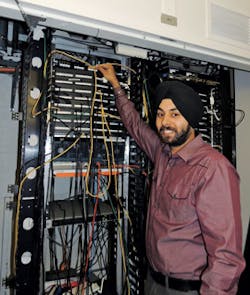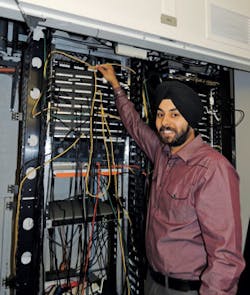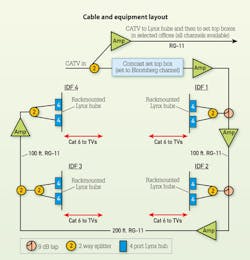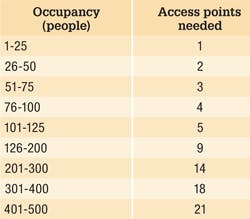From the April, 2014 Issue of Cabling Installation & Maintenance Magazine
A Chicago-based futures commission merchant relies heavily on news and business feeds for its daily activities, and relies on a Category 6 infrastructure to deliver them.
By Richard Parrish, MindShare Communications
Expanding and moving to new offices or remodeling existing trading offices is an ideal time to significantly upgrade and streamline any business's information technology (IT) infrastructure. Such was the case with Advantage Futures (www.advantagefutures.com) about one year ago when it moved from the Chicago Board of Trade to all-new, custom-designed facilities in the heart of the city's financial district.
Prior to the move, nearly 40 miles of high-performance cable and advanced equipment were installed to serve 48,000 square feet of custom-built space with state-of- the-art data-communications, telecommunications and television services. Advantage now delivers 1000Base-T Ethernet, Voice over Internet Protocol (VoIP) and cable television on its infrastructure.
Category 6 cable was a key part of the infrastructure upgrade. It is tested for performance at frequencies up to 250 MHz and is suitable for 10Base-T, 100Base-T and 1000Base-T up to 100 meters, and 10GBase-T to certain distances as well. Equally important, the cable transfers data at very high speeds thanks to its ability to minimize pair-to-pair crosstalk and reduce system noise.
A vital technology improvement also included switching the television-distribution network from conventional coaxial to Category 6. According to Sim Sabharwal, vice president of information technology at Advantage Futures, the new system provides ultimate flexibility for handling moves, adds and changes (MACs) of television locations.
Employees and customers use the new offices for high-volume trading operations, and often move from one suite to another as their needs change. When that happens, they need immediate access to political and financial news without waiting for maintenance people to pull coaxial cable to their new location.
Advantage has experienced exponential growth since it began in 2003. Last year it processed trades for more than 290 million futures contracts, making it one of the top futures commission merchants (FCM) in the nation. An FCM provides third-party clearing and settlement services for futures transactions executed on futures exchanges. All members of a futures exchange are required to clear their trades at the end of each trading session and must maintain sufficient funds to cover their debit balances. An FCM is responsible to all members of an exchange for the fulfillment of contracts.
In addition to employing about 100 people for its international trade clearing operations, Advantage offers 45 single desks and 40 private suites for independent trading firms. These firms sometimes employ up to 60 people.
"One of the biggest challenges was finding a television network that provided flexibility and scalability to easily add or move TVs to any location," Sabharwal reported. "We wanted TVs for our employees, TVs for traders, and TVs for public areas. Television service is essential for traders, who need up-to-the-minute information on world news, financial news, and market conditions around the world.
"There's quite a bit of movement on the trader's side, as new firms come on board and existing firms grow and add people," Sabharwal explained. "So we need to be able to move the TVs and the TV signal from one office to another without having to pull new cables."
CATV on Category 6
Sabharwal's IT team wondered if they could deliver cable television on Category 6 cable, so they searched online and found Lynx Broadband (www.lynxbroadband.com). Using Lynx hubs to distribute TV signals throughout Advantage's new offices, he was able to develop an ideal system for his application.
The network starts with RG-11 coaxial cable delivering programming to a Comcast set-top box, which is usually tuned to the Bloomberg channel. The HD signal is then delivered to Lynx hubs in intermediate crossconnects located in the four corners of the office area.
The Lynx hubs use RF baluns to convert the cable signal to a balanced signal that travels on Category 6 to the point of use. Then a Lynx converter turns it back to an unbalanced signal that enters the TV through a conventional F connector.
Sabharwal worked with Gregg Kelley, national sales manager for Lynx Broadband, to design the network. The design and related drawings made it easy for Sabharwal's team to install the entire system themselves.
One-hour install and setup
A significant advantage of a home-run Category 6 network, compared to traditional tap-and-drop coaxial, is improved reliability because there are no taps, splitters or other connectors between the wiring closet and the point of use. One Category 6 cable goes to one TV, which greatly simplifies installation and troubleshooting.
A variety of 35 large, flatscreen TVs are connected to the Advantage/Lynx network. Eighteen are tuned to the Bloomberg Network and distributed around the open office for employee viewing. Six TVs are in private offices used by traders, while the others are in conference rooms, reception areas and break rooms.
In a few cases, the "in-wall" distance from the patch panel to the data jack exceeded the 90-meter standard-specified cabling distance, which reduced the signal strength and compromised picture quality. "We consulted Lynx and ordered more amplifiers," Sabharwal said. "After adding the amplifiers, everything was good."
Sabharwal and his team of four people installed the Lynx network in approximately one hour--including installing the set-top box, the amplifier, hubs, and the converters where the TVs are located.
"One of the features I like best is the ability to handle a variety of applications," he continued. "The 18 TVs used by our employees display only the Bloomberg channel, but the same system can deliver the full spectrum of Comcast channels to set-top boxes in a trader's office. The trader can change channels at will, and it only affects his TV."
Each employee and trader's desk is equipped with four data jacks. All Sabharwal has to do to change a TV location is to move a patch cord in the intermediate crossconnect, unplug from the data jack in the old TV location and re-plug at the data jack in the new location.
Another advantage of the new TV system is its cost--only $6,000 for the equipment and amplifiers. This was a relatively modest investment compared to all the TVs, which cost $17,500.
Richard Parrish is president of MindShare Communications. Parrish authored this article on behalf of Lynx Broadband. He can be reached at [email protected].
Archived CIM Issues




